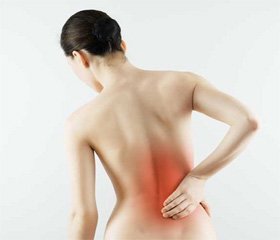Международный неврологический журнал 7 (69) 2014
Вернуться к номеру
The aggravation of lumbar pain syndrom: clinical substantiation of pharmacological therapy of vegetative and myofascial dysfunction
Авторы: Perova V.P.
Рубрики: Неврология
Разделы: Справочник специалиста
Версия для печати
vertebrogenic pain syndromes, autonomic dysfunction, myofascial dysfunction.
Background
Purpose. The aim of the research was to examine the overall autonomic regulation and electromyographic characteristics of the reaction of back muscles during the aggravation of low back pain, their relation to the severity and duration of pain.
Materials and methods. 200 patients with acute aggravation of chronic low back pain (87 men, 113 women) were examined. The average age of patients was 42.30 ± 11.08 years. There was a clinical and neurological examination with assessment of pain intensity according to Visual analog pain scale (VAS). The method of surface electromyography (interference) was used in order to study the electromyographic characteristics of the muscle's reaction. The condition of autonomic regulation in examined patients was evaluated by the method of variative pulsometry. according to the intensity of pain was identified 3 groups of patients: with a mild pain syndrome (VAS < 40 mm) — 21 (10.5 %), pain syndrome with moderate severity (VAS 40–60 mm) — 99 (49.5 % ) with severe pain syndrome (VAS > 60 mm) — 80 (40 %). For the duration of the disease, patients were divided into two groups: 1 to 3 years — 109 (54.5 %), 4 years or more — 91 (45.6 %). The process of statistical data was performed in the statistical package SPSS20 (© SPSS Inc.).
Results. Changes of indicators of variative pulsometry during the aggravation of lumbar pain depended on the reduction of the percentage of successive normal sinus RR intervals > 50 ms (pNN50%) and performance variability (standard deviation of all normal sinus RR intervals — SDNN, variation coefficient – Cvar) and reducing power spectrum curve of RR intervals and its components (very low frequency (VLF), low frequency (LF), high frequency (HF). Indications of estimation by Baevsky show a decrease of parasympathicotonic impact and a significant increase in the tension of the sympathetic division of the autonomic nervous system (the index of autonomic balance and the index of tension of regulatory systems were increased). In patients with duration of the disease of more than 3 years, there is a predominance of sympathetic influences. The index of autonomic balance and the index of tension of regulatory systems were increased are significantly higher than in groupwhich are ill for 3 years. This may reflect the benefit of reducing adaptive capacity with increasing disease duration. Severity of pain, duration influence the severity of autonomic disorders.
Analysis of the received electromyographic data showed that patients with acute aggravation of low back pain is typical bilateral decrease in the amplitude of oscillations of the electric potential of the muscles of the back, which was expressed as strengthening the intensity of pain and with increasing duration of disease.
Conclusion. Results of the study demonstrated the presence of significant autonomic and myofascial dysfunction in patients with acute aggravation of low back pain. Severity of pain, its duration influence the nature and severity of autonomic and myofascial disorders.
1. Baevskii R.M., Kirillov O.I., Kletskin S. Z. Matematicheski ianaliz izmenenii serdechnogo ritma pri stresse. — M., Nauka, 1984. — 176 р.
2. Voznesenskaya T.G. Boli v spine: vzglyad nevrologa // Concilium medicum. — 2009. — № 2. — Р. 75-79.
3. Podchufarova E.V., Yakhno H.H., Alekseev V.V., Avedisova A.C., Chakhava K.O., Ershova E.M., Protasenko T.V. Khronicheskie bolevye sindromy poyasnichno-kresttsovoi lokalizatsii: znachenie strukturnykh skeletno-myshechnykh rasstroistv i psikhologicheskikh faktorov // Bol'. — 2003. — № 1. — Р. 38-43.
4. Ma V.Y., Chan L.,Carruthers K.J.. Incidence, prevalence, costs, and impact on disability of common conditions requiring rehabilitation in the United States: stroke, spinal cord injury, traumatic brain injury, multiple sclerosis, osteoarthritis, rheumatoid arthritis, limb loss, and back pain // Arch. Phys. Med. Rehabil. — 2014. — 95 (5). — 986-995. doi: 10.1016/j.apmr.2013.10.032.
5. Deyo R.A., Dworkin S.F., Amtmann D., Andersson G., Borenstein D., Carragee E., Carrino J., Chou R., Cook K., DeLitto A., Goertz C., Khalsa P., Loeser J., Mackey S., Panagis J., Rainville J., Tosteson T., Turk D., Von Korff M., Weiner D.K. Report of the national institutes of health task force on research standards for chronic low back pain // J. Manipulative Physiol. Ther. — 2014. — 37(7). — 449-467. doi: 10.1016/j.jmpt. 2014.07.006.
6. Storheim K., Zwart J.A. Musculoskeletal disorders and the Global Burden of Disease study // Ann. Rheum. Dis. — 2014. — 73(6). — 949-950. doi: 10.1136/annrheumdis-2014-205327.
7. Sitthipornvorakul E., Janwantanakul P., Purepong N., Pensri P., van der Beek A.J. The association between physical activity and neck and low back pain: a systematic review // Eur. Spine J. — 2011. — 20(5). — 677-689. doi: 10.1007/s00586-010-1630-4.
8. Vassilaki M., Hurwitz E.L. Insights in public health: perspectives on pain in the low back and neck: global burden, epidemiology, and management // Hawaii J. Md Public Health. — 2014. — 73(4). — 122-126.
9. Yelnik A. Epidemiology of physical disabilities in France // Sons. — 2014. — (785). — 26-28.

